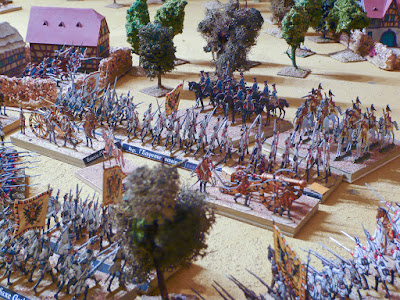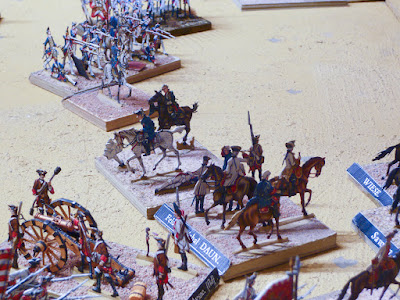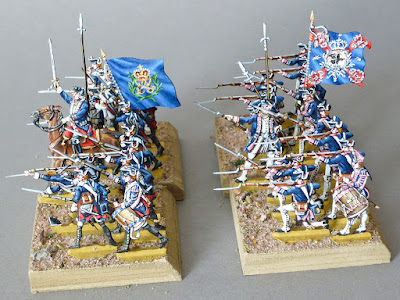I wanted to share a couple of pics with my paint jobs done November 2016 through May 2017. I haven't managed to post much during that time, besides our Hochkirch Refight. I continue to pursue my self chosen mission to complete at least a 100 miniatures in a year from among my drawers pile of unpainted miniatures left. I wasn't idle, really.
During May, I finished a battalion of Prussian Grenadiers. Converged IR 13 & 26. For the first time, I added a battalion gun with an infantry stand. I'm very pleased with the result. After all, I found a good use of my various flat gun models that I have.
These firing grenadier miniatures are a real treasure. Very rare old pre WWII casts of Kieler Zinnfiguren. I'm afraid you cannot buy them anymore. Really wonderfully sculptured or better engraved casting moulds were mastered here. The gun model is a Berliner Zinnfiguren 6-pounder model - their take, I should say, but quite fine dimensionwise.
During March and April 2017 I did two infantry regiment stands. One is the Prussian IR 18 Prinz von Preussen, or Prince Royal, with my units throughout French language labeling. The other is the Hesse-Cassel regiment Mansbach (IR 8). The miniatures are a mix of various foundries. Mostly Scholtz – i.e. Berliner Zinnfiguren.
Earlier in February I painted another battailon or Prussian converged Grenadiers. Its the elites from among the Prussian crack regiments Garde IR 15 & Prinz von Preussen IR 18. Miniatures are mostly Hamburg based Herbu foundry. The smart looking mounted officer is from Scholtz, Berlin.
In January, I painted a nice set of French dismounted dragoons. Its the regiment of d'Apchon, I did here.
Really smart looking lads.
I had this set of figures on my must-have-list since the 1980's! Believe it or not, but I only managed to buy them last year. I never had any use for dismounted cavalry in my rules, until my research on the French 7YW army during the early 2000's revealed that French dragoons had been seen fighting dismounted moreoften during the war, as they were more seen as light troops rather then cavalry of the line.
Finally, during Nov-Dec 2016 I painted a whole load of Russian Cannoniers. They are mostly figures from my late friends collection that I inherited. My now completed range of rather authentic looking 7YW Russian gun models, that I had done during the previous years demanded for equal looking Russian Cannoniers. Only thanks to a present by Jim Purky, the gun models could be completed with three more of his wonderful Fife&Drum Foundry Russian Unicorn models. I now have 7 gun models completed. Two more of the F&D Unicorn models & a Foundry medium cannon I still need to do. The Cannoniers I did in rather short time. Its 58 men total. Enough to man my gun models. Most are Kieler Zinnfiguren, a number are conversions of mine & 6 rather obscure figures seem to originate from a Russian foundry – not a German one.
#
The Fife&Drum Unicorn is the mosle left model in above image.
Two Foundry Schuwalov secret howitzers seen here. The gun crew of the front piece appear to be figures from a Russian based foundry. Very nice figures. They were already painted rather nice. I just added a bit more highlights and shading. I'm not so sure about the head gear. These mitres look more like Viennese gondolas. Apart from my frew grenadiers intermingled with my gunners, they are the only ‘real’ Russian miniatures. Bombardiers they are, rather then Cannoniers. All other figures are Prussian gunners, really. No German foundry supplies Russian models, as far as I'm aware.
05 June 2017
24 March 2017
Refighting The Battle Of Hochkirch 14 Oct. 1758
Last weekend we had a rather spectacular game, refighting the battle of Hochkirch, refought with approx 1,200 miniatures. Two players on the Austrian side, including myself, and 1 player for the King of Prussia's heroic ‘Spartans’. The Scenario is provided by Frank Chadwick's Battles of the Seven Years War, vol. I (Austria versus Prussia) for Volley & Bayonet rules.
With the Hochkirch church bell sounding the 5th hour a mighty thunderstorm cought the sleeping – and almost unsuspecting – Prussians in their Camp.
Above see a panorama view of the spectacle. The Austrian attack came in pretty much according to the historic dispositions. A massive reenforced left wing of 4 columns directed into the Prussian flank and rear. To represent the Prussians being ‘caught sleeping’, all Prussian units started the game disordered.
Below see my orbat sheets arranged for the two armies with this game. For copyright issues, I did not include the V&B scenario map for Hochkirch. But plenty of maps of the battle should be found in the internet, anyway.
With all Prussians being disordered it was too big a temptation to resist for my co-player L***. He commanded on the left and instantly threw in all the horse of Loudon's corps as well as Odonell's cavalry attacking into the Prussian rear. The infantry was outside sriking distance with the start of the first turn. It was Ziethen's right wing cavalry that got hit. Hit really hard! The two cuirassier brigades were routed in a minute. An Austrian cavalry breaktrough in the first turn. Now they continued charging into a regt. of Kanitz's right wing infantry and a battery of artillery – both routed as well. Only the Löwenstein's chevaulegers attacking the fieldwork head on were repulsed. A good try, but possibly too daring. With this hard hitting good start, the real work started for the Austrians. Despite being greatly outnumbered, our opponent M*** was very determined to win this battle with his Prussians, of which a good number of units were his own miniatures. The greater part only recently painted and here seeing their Test-of-Battle.
The fight for the fieldwork became very obstinate. The Prussians refused to leave it to the Austrians bringing in ever more troops for its defence, all the while Ziethen held off Odonell's troops with what was remaining from his division. Ziethen even managed to order one of the Croates battalions to turn about and oppose another battalion of Loudon's Croates.
Above see the detail of this rare action right near Ziethen's command stand. My co-player L*** really shot at his own troops by rolling dice (a miss). I have never had this before in all the wargames I played in my life.
Above see a detail of one of those Prussian desparte counter attacks led by Feldt-Maréchal Keith. I think it was the crack Archi Duc Ferdinand IR 2 that got wiped out here. The Austrians were repulsed oncemore, but, Keith was killed on this occasion just as in the real historic battle. I'm serious. As I don't have his character for the time being, it was my Feldt-Maréchal Schwerin command stand, that represented Keith in this game. Aye. May the finest among Frederick's generals rest in piece.
Shortly later, prince Maurice, the soul of the Prussian infantry, was killed in our game as well, just as in the real historic battle. He is seen here along with the regt. Forcarde (IR23) in close combat with that days brilliant performing Esterhazy regiments. I believe the location of Maurice being mortaly wounded was very near the historic location, as far as it can be reconstructed from available historic records.
For the attacking forces of Her Imp.&Royal Majesty's Army, progress at the southern front of the battle was slow. The fieldwork still being in Prussian hands after several turns, as well as Hochkirch. The situation turned as the attack of the Austrian right wing commanded by general Ahrenberg closed in on the Prussian left wing & Wuerttemberg's Reserve Corps, all found in the northern part of the battlefield area, tasked to secure the Prussian line of communication.
The contest for the villages of Rodewitz and Wawitz became a violent and bloody affair. This strike was directed to cut the Prussian line of retreat. Very bad news. The Austrians were determined to finish off with the entire army of this Potsdam Resident Thief Of Silesia. The Prussian grenadiers fought like lions, but, to the disgust of the Prussians, it was also observed that Austrian volley fire was executed most effective and deadly. They weren't all that good with the bayonet that day, I must say. But so much better with ranged fire. The Prussian grenadiers melted away within short. The regiment Gaisruck's orderly volleys were found particular deadly. This regiment killed all that dared to close into firing range. In the event, also Forcade's division was crushed within short.
Not much happened along the Austrian centre front along the stream. Colloredo deployed his troops here for the greater time of the battle only to threaten the two crossings over the stream at Niethen and Kuppritz, but otherwise secured the communication between the Austrian right and left wing striking forces.
At around noon, the Prussian army was facing total defeat. The crack regt. Garde deployed near Hochkirch now came under attack of the Austrian converged elite squadrons of general Ayasasa under the direct command of maréchal Daun. Massed artillery poured in its fire into the Prussian Gardes flank in support. No chance. The Austrian elite horse was repulsed. Meanwhile, Loudon seized Hochkirch by dislodging the defending Prussian Chasseurs from the village.
The Gardes now wanted to make good their excape along with the other remnants of Frederick's now shattered Army. No chance. Massed Austrian artillery blocked the Prussian retreat path. Now also the Gardes were knocked out. After completing the 12.00 hours turn, the battle was over.
On above image you see Maréchal Daun in his moment of maximum triumph. The King of Prussia surrenders and hands Daun his saber. Victoria to the House of Austria. VIVAT MARIA THERESIA.
Summery:
A great game it was. The Austrians really needed every single unit of its army. The Prussians fought like lions. If the Prussians hadn't lost 4 units routed in the first turn, who knows, the outcome may well have been more favorable for the Prussians. Losses on both sides were high. As far as I can recollect the figures from our orbat sheets, Austrian losses were 14,000 men & 20 guns, while the Prussians lost 13,000 men & 75 guns not including prisoners.
 |
| The famous great field work just south of Hochkirch under assault of Loudon's cavalry. |
 |
| Closer view of the fieldwork with the village of Hochkirch located just behind it. |
Above see a panorama view of the spectacle. The Austrian attack came in pretty much according to the historic dispositions. A massive reenforced left wing of 4 columns directed into the Prussian flank and rear. To represent the Prussians being ‘caught sleeping’, all Prussian units started the game disordered.
Below see my orbat sheets arranged for the two armies with this game. For copyright issues, I did not include the V&B scenario map for Hochkirch. But plenty of maps of the battle should be found in the internet, anyway.
 |
| I must say, I never saw a more formidable Austrian army lined up for the attack. I've inserted my units here, off course. A many are historic & also found at their historic position. |
 |
| View of Loudon's & Odonnell's troops attacking from south & west directions. |
 |
| MacBrady's grenadiers closing in. The exploding bomb-shells, neatly painted by M*** add to the drama here. |
 |
| The left column of Sincère's command under general Forgàtch attack the fieldwork from the left side. Here its the grenadiers of Cogniazzo and Fiorenza that try hard to take it. |
The fight for the fieldwork became very obstinate. The Prussians refused to leave it to the Austrians bringing in ever more troops for its defence, all the while Ziethen held off Odonell's troops with what was remaining from his division. Ziethen even managed to order one of the Croates battalions to turn about and oppose another battalion of Loudon's Croates.
 |
| Friendly Fire in the heat of the Action! |
Above see the detail of this rare action right near Ziethen's command stand. My co-player L*** really shot at his own troops by rolling dice (a miss). I have never had this before in all the wargames I played in my life.
 |
| The death of Feldt-Maréchal Keith. |
 |
| D'Aisne's troops attack on the right of the fieldwork. |
 |
| Loudons fight to crush the Prussian front in the south continues. |
 |
| Ahrenberg's troops or the right wing of the Austrian force engage the cavalry of Wuerttemberg & the Division Forcade deployed in and around the villages of Rodewitz & Wawitz. |
 |
| Buccow's cavalry of the right in concert with infantry from d'Arberg's Division crush Wuerttembers Reserve Corps. It turned the odds in favour of the Austrians in this part of the world. |
 |
| Now the Austrian right wing closes in on Forcade's crack troops. |
Not much happened along the Austrian centre front along the stream. Colloredo deployed his troops here for the greater time of the battle only to threaten the two crossings over the stream at Niethen and Kuppritz, but otherwise secured the communication between the Austrian right and left wing striking forces.
 |
| At around noon, the Grand Fielwork was eventually abandoned by the Prussians. Loudon's command stand seen on the right is pleased to see it in Austrian hands now. |
 |
| The final stage. The Prussian Gardes under attack. |
 |
| A bit out of focus, but it remains the key scene of Prussian total defeat. The Gardes are swept off the field by deadly ‘canister brooms’ delivered at point blank range. |
 |
| Finale. Daun accepts Frederick's surrender. |
Summery:
A great game it was. The Austrians really needed every single unit of its army. The Prussians fought like lions. If the Prussians hadn't lost 4 units routed in the first turn, who knows, the outcome may well have been more favorable for the Prussians. Losses on both sides were high. As far as I can recollect the figures from our orbat sheets, Austrian losses were 14,000 men & 20 guns, while the Prussians lost 13,000 men & 75 guns not including prisoners.
Subscribe to:
Posts (Atom)






























